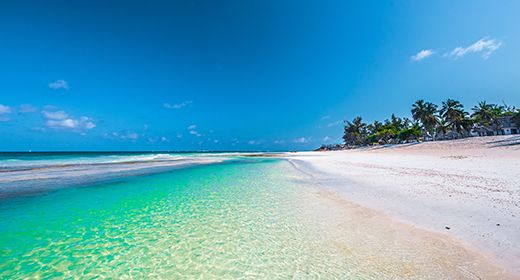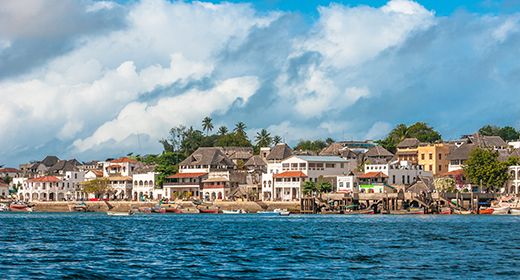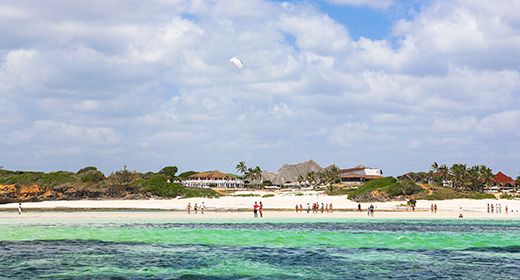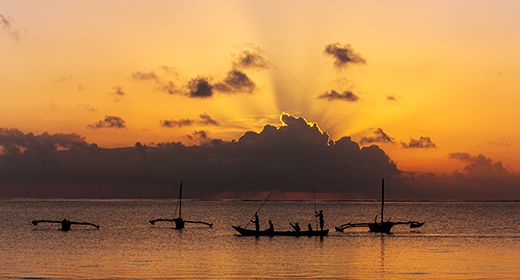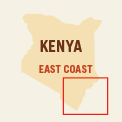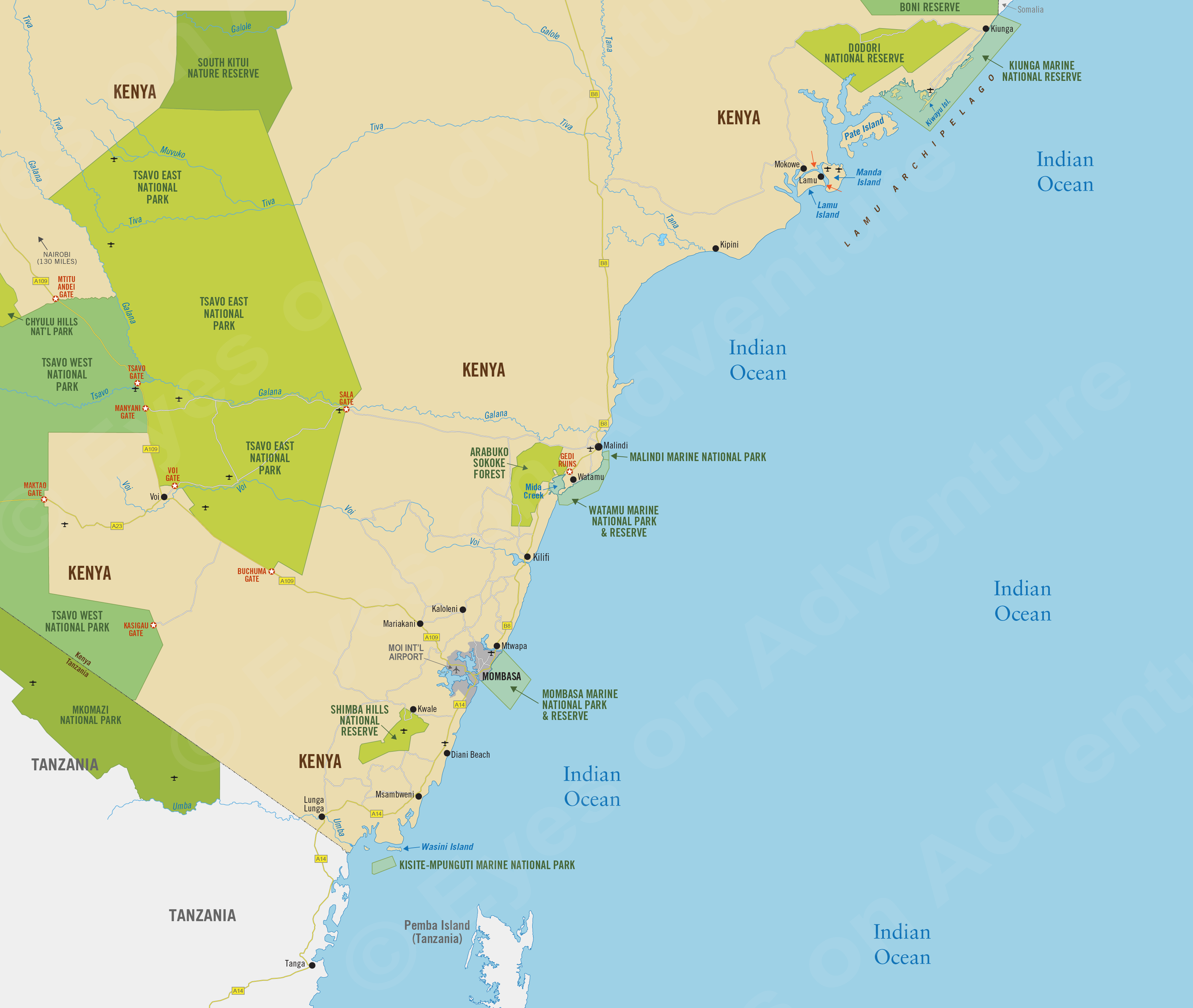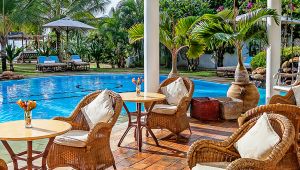East Coast Kenya
(incl. Diani Beach, Malindi, Watamu, Lamu, Mombasa)
Region Links: Amboseli & Chyulu Hills, East Coast Kenya, Great Migration, Laikipia, Masai Mara, Nairobi, Rift Valley & Central Highlands, Samburu, Tsavo
Highlights
- Diani Beach for beautiful waters and plenty of accommodation
- Arabuko Sokoke is the last coastal forest in East Africa
- Watamu and Malindi for snorkeling and diving in marine reserves
- Lamu Archipelago is remote and feels like stepping back in time
- Shimba Hills offers day-trip safaris easily reachable from the coast
EOA Recommends: AfroChic Diani Beach, Kinondo Kwetu, The Red Pepper House
Kenya's Indian Ocean coast is sometimes called the 'Swahili Coast'. Mombasa is Kenya's oldest city and the miles of shoreline are a tropical paradise of white-sand beaches, historic towns, and warm, turquoise waters.
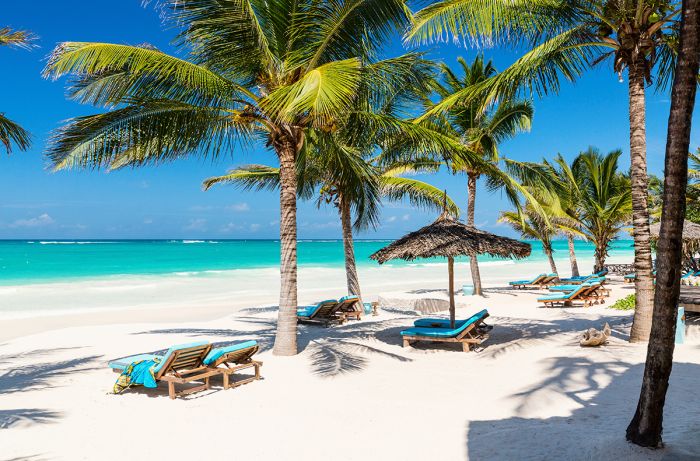
Beach setting on Kenya's Indian Ocean coastline.
The Kenyan coast spans 882 miles (1 420 kms) from Somalia in the north to Tanzania in the south. Numerous offshore reefs support bountiful marine life and offer some of the world's finest diving, snorkeling and fishing. Diani Beach in the south, Malindi (just north of Mombasa) and Manda and Lamu in the far north are all beautiful destinations.
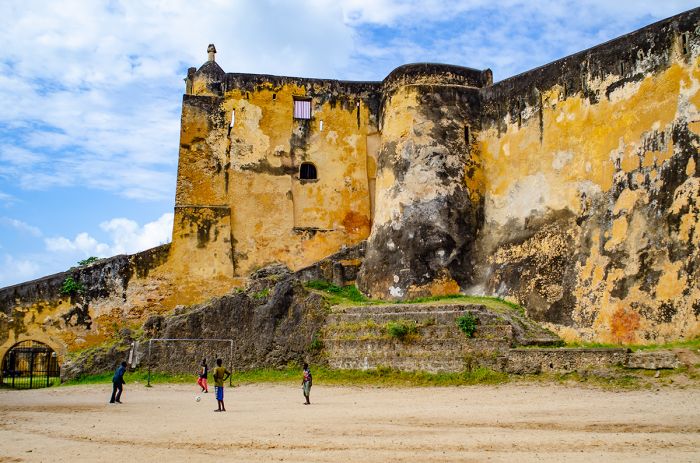
Historic Fort Jesus in Mombasa, completed in 1596.
Protected marine areas along the coast include Malindi National Park, Mombasa Marine National Park, the Lamu Archipelago, and Kisite-Mpunguti Marine National Park. Inland wildlife reserves include Shimba Hills, Arabuko Sokoke, and Dodore National Reserve in the far north.
The coast is also full of history, most notably in Mombasa, which dates back to around 900 AD and has long been the pre-eminent trade port on the African coast.
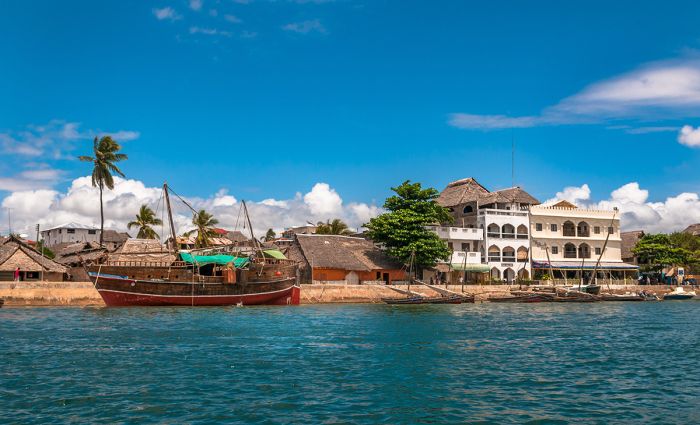
Historic Lamu Town on Lamu Island, north coast Kenya.
Most visitors to Kenya come for its well-known wildlife reserves, but Kenya's east coast is a world-class beach destination and a great add-on to a safari!
Read More...
Arabuko Sokoke, Diani Beach, History, Kisite-Mpunguti, Kiunga, Lamu, Malindi, Mombasa, Mombasa Marine NP, Shimba Hills, South Coast, Watamu
History
Accounts vary in terms of the earliest human settlements at Mombasa and most recorded history begins with the Portuguese domination in the late 1400s. Fossil records suggest that Mombasa has certainly had some for of settlement for at least 2 000 years.
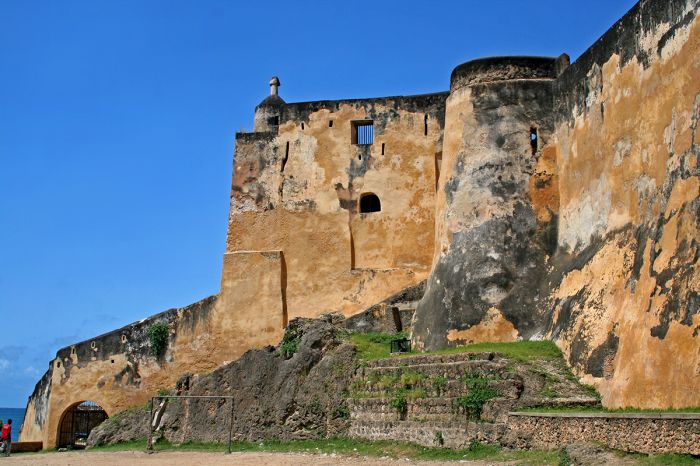
Fort Jesus in Mombasa.
Written Arabian, Indian, and Chinese records confirm that Mombasa was a prosperous and important trading center for gold, spices, and ivory as early as the 12th century. Mombasa'a oldest mosque, 'Mnara', was built around 1300.
Vasco de Gama is the earliest known European to visit Kenya's east coast, arriving in 1498, but was repelled at Mombasa and so landed north at Malindi, where an alliance was formed with the local rulers there. A Portuguese fleet returned and attacked Mombasa in 1505 and sacked the town, burning it to the ground and killing over 1 500 locals. A rebuilt Mombasa was again plundered by the Portuguese in 1528 and twice more in the 1580s.
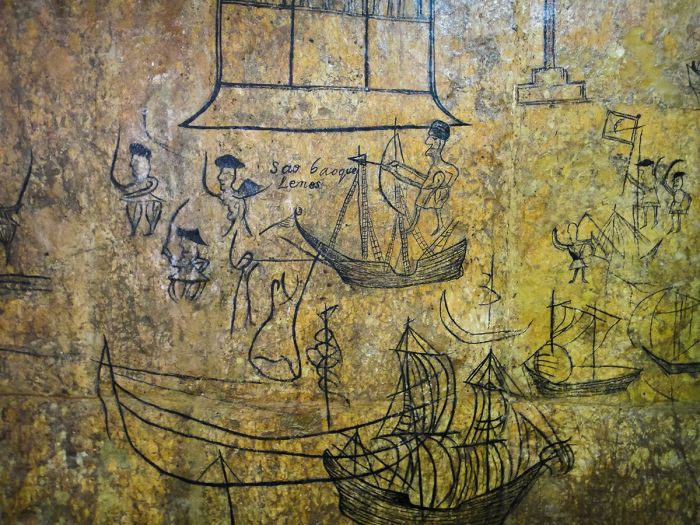
Old drawings of Portuguese sailors on the walls of Fort Jesus.
Throughout the 1500s, Portugal gained control of Mombasa, Malindi, and all the way north to Lamu. In 1589, they started work on Fort Jesus to protect and administer the Old Port of Mombasa. The fort was completed and dedicated in 1596 and was used by Portugal in its attempt to control Indian Ocean trade. In the ensuing 100 years, Mombasa and Fort Jesus were captured and recaptured at least nine times, changing hands between the Portuguese and various Omani, who were also vying for power and control of the regional trade routes.
The Omani Arabs were gaining power in the region and in 1698, after a 33-month-long siege that ended in the starvation or death by plague of all Portuguese corps and 1 500 Swahili loyalists at Fort Jesus, the Sultanate of Oman gained control of Mombasa. The Omani also gained control of Zanzibar and much of what is today the Kanya/Tanzania coastline. This ended Portugal's presence and control of the coast.
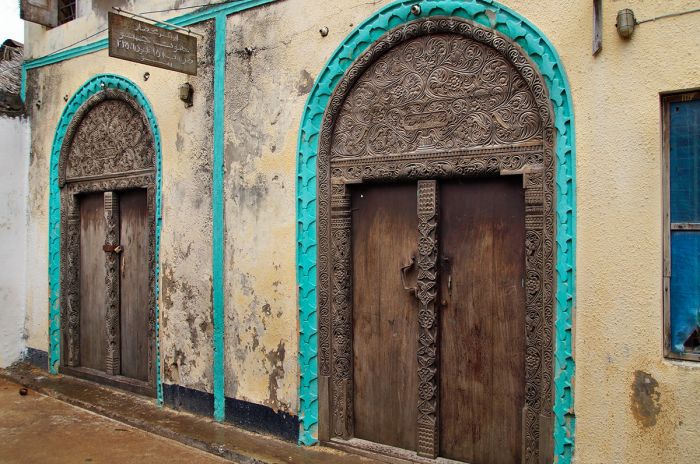
Old doors in historic Lamu Town.
Throughout the 1700s and up to the late 1880s, the Omani Sultanate controlled much of Africa's Swahili Coast, which included Lamu, Malindi, Mombasa, Dar es Salaam, Zanzibar, and into northern Mozambique. As Mombasa grew in economic importance, the northern coastal centers of Malindi and Lamu shrank to small outpost towns.
In the latter part of the 19th century, Germany and Britain were plotting to colonize Africa and during the late 1880s, the two countries divided up control and ownership of most of East Africa. Kenya and coastal Tanzania fell under British control in 1890 and Fort Jesus became Mombasa's prison. The fort became a museum in 1962. Kenya gained independence from Britain in 1964.
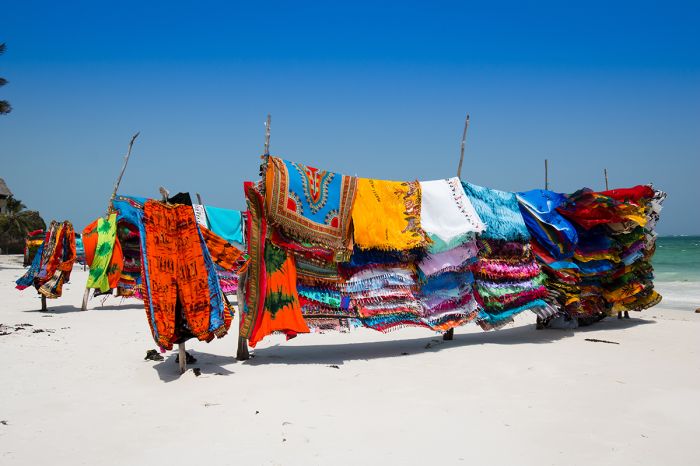
Colorful fabrics for sale on Mombasa Beach.
The South Coast
The region south of Mombasa is known as the South Coast. The coastline here is one long, continuous beach, interrupted only a few times by rivers and streams, that continues all the way to the Tanzanian border. The only developed area along the South Coast is Diani Beach.
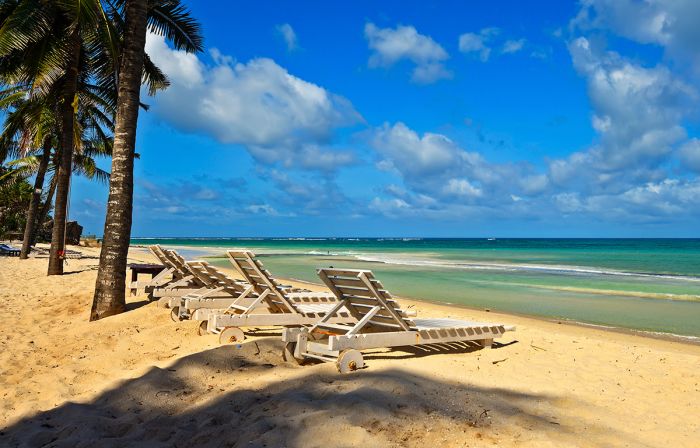
Diani Beach and view over the Indian Ocean.
DIANI BEACH
Diani Beach (19 miles/30 kms south of Mombasa) is a picturesque seaside beach with palm trees, white sands and beautiful, blue Indian Ocean water. Most lodges here are upscale and all-inclusive and although not crowded compared with beaches along the Mediterranean, it is the most touristy of Kenya's beach destinations.
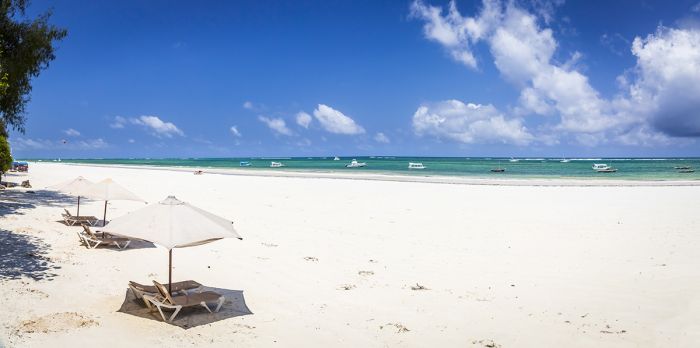
Diani Beach on Kenya's Indian Ocean coast.
The reef at Diani lies 2000-3000 feet (600-1000 meters) from shore and the lagoon within is calm and great for swimming. The reef itself (swim or take a dhow) is great for snorkeling. Various excursions are available from most hotels including, snorkeling, diving, fishing, day trips to Shimba Hills and Tsavo East, and any water sport you can imagine.
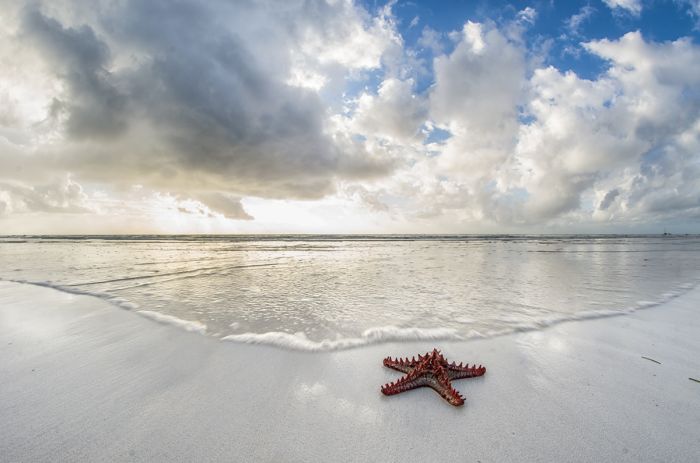
Starfish on Diani Beach, Kenya.
Further south from Diani is Msambwebi, a quaint village with a pristine and remote beach. There is limited but excellent accommodation. The beach here is quiet, lovely, and backed with cliffs, with no beach vendors or tourists, but the tide goes out for many miles and the water sports and snorkeling here are not ideal.
SHIMBA HILLS NATIONAL RESERVE
Shimba Hills is an hour's drive from Mombasa and is situated just inland from Diani Beach. The hills here rise up to 1 312 feet (400 meters) and the reserve presents a lovely day trip and respite from the humidity along the beaches.
The reserve covers 74 square miles (192 sq kms) of hilly terrain covered in grassland, woodland, and rainforest.
Wildlife in Shimba is good, with plenty of buffalo, bushbuck, zebra, warthog, hippo, several species of duiker, suni, and a small herd of Maasai giraffe (introduced in the 1990s). Ostriches have also been introduced and are thriving.
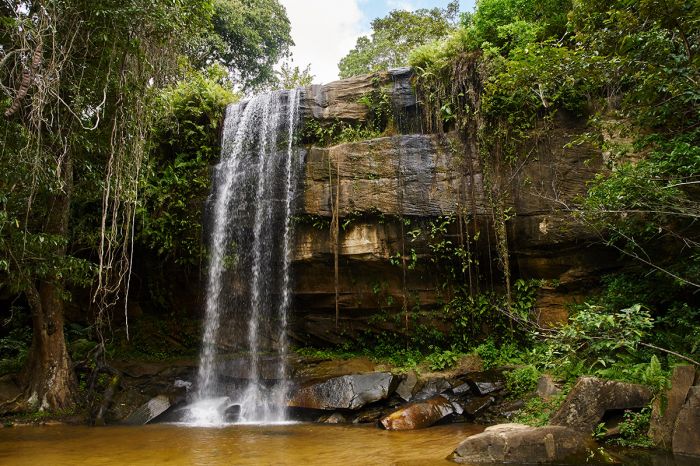
Sheldrick Waterfall in Shimba Hills Reserve, Kenya.
Sable antelope are common and indigenous in Shimba and the reserve is the only remaining place in Kenya to see these lovely animals. Elephants are also likely to be seen on a game drive in the park.
Shimba's lions are long gone, but leopards range throughout the park and serval are here too. Primates are plentiful, with Angola colobus, yellow baboon, and both Sykes and vervet monkey.
Shimba Lodge, a 'tree' hotel like Treetops or the The Ark (Aberdare NP), but with a superior experience, is a good place to stay or stop for lunch.
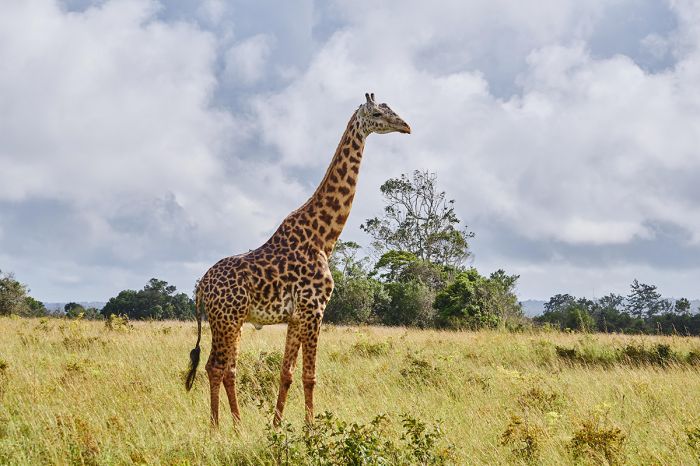
Giraffe in the Shimba Hills Reserve.
Malindi and Watamu
North from Mombasa 71 miles (115 kms) up the coast lies Malindi. Vasco da Gama and his fleet came to Malindi in 1498 and it became the Portuguese operations center for the next 100 years (until they eventually conquered Mombasa). Today Malindi remains Kenya's second-largest port city (population 120 000), while Watamu is a smaller, more quaint resort town.
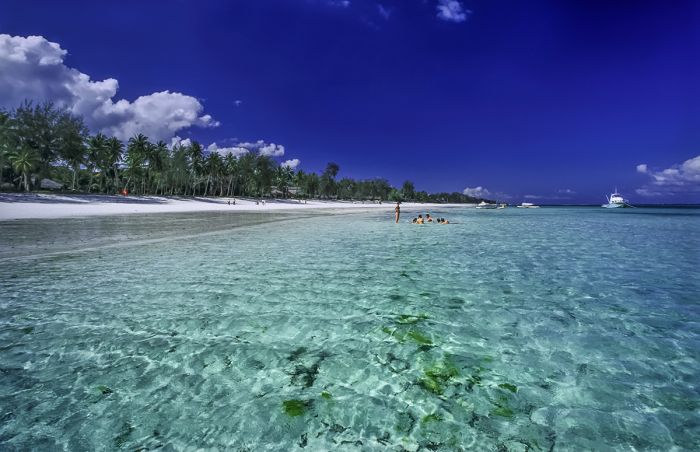
Beach view at Malindi, Kenya.
The 9 miles (15 kms) of beach between Malindi and Watamu are some of the best in the country, and are protected by the combined Malindi/Watamu Marine National Park and Reserve. Established in 1979, they are the oldest marine reserves in Africa, and protect 82 sq miles (213 sq kms) of beaches, reefs and open water starting at Malindi and running south past Watamu to the Mida Creek Estuary. The snorkeling and diving here are superb and the marine life prolific, with warm, calm waters, good visibility, and very habituated marine life.
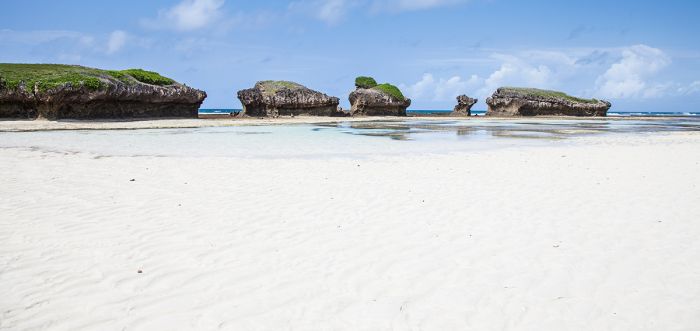
Indian Ocean beach at Watamu, Kenya.
South of Watamu is the Mida Creek Estuary, which offers exceptional birding. The site is a crucial winter habitat for Palearctic migrants, while just inland in the surrounding coastal grasslands, specials like the rare Sokoke pipit can be found.
Arabuko Sokoke National Forest
The Arabuko Sokoke Forest is the largest remaining tract of coastal forest in East Africa at 162 sq miles (420 sq kms). In ancient times, it would have been part of the massive tract of forest which ran along the coast from Mozambique all the way north to Somalia.
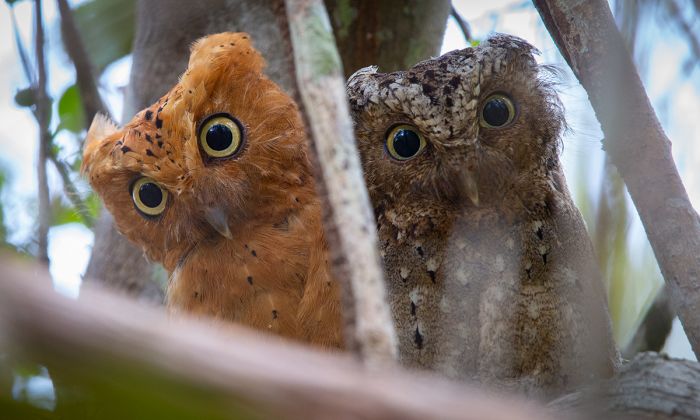
Sokoke Scops-owls. (Copyright © James Weis)
The forest supports a small number of elephants, which are rarely seen, Sykes' monkeys and yellow baboons, but the main attraction here is the bird life. There are six globally endangered bird species in the forest, including the lovely Sokoke scops-owl and the Sokoke pipit.
Bordering the Sokoke forest are the enigmatic Gedi Ruins; definitely worth a visit if you are staying in this area. The ruins are from a medieval Swahili town dating back to the 11th-13th century and today the dense forest has grown over the town, which has been deserted for three centuries. Ghost stories and other local superstitions surround the site and its absence from historical records seems inexplicable.
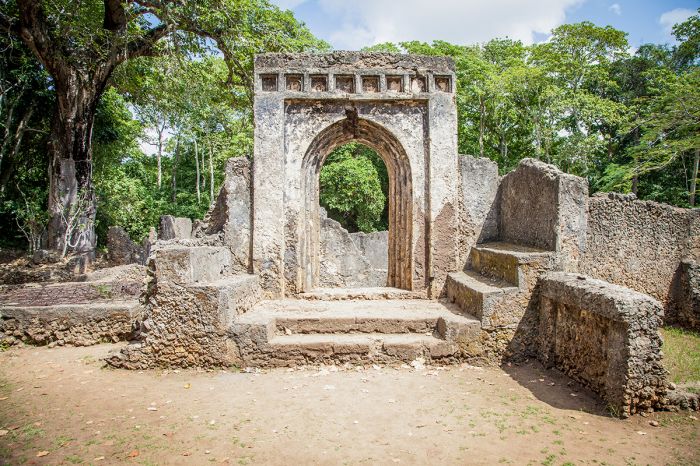
Gedi Ruins near Watamu, Kenya.
Lamu Archipelago
Situated far north along Kenya's coastline and very close to the Somalia border are the Lamu Archipelago. Comprising Pate, Lamu and Manda islands, plus numerous smaller islets, they are the most remote of Kenya's Indian Ocean destinations.
The settlement on Lamu Island was originally named "Al-Amu" by the Arabs, which became translated as "Lamon" by the early Portuguese merchants. The name was soon applied to the entire island and eventually to the region and islands as a whole.
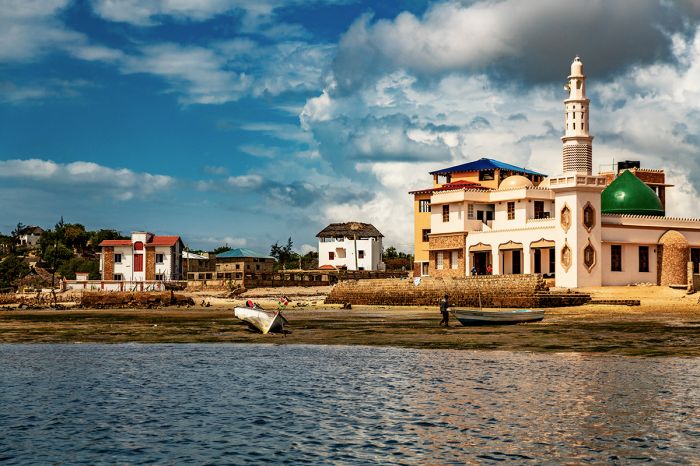
Houses and Riyadha Mosque, Wiyoni district, Lamu Island.
Lamu Town on Lamu Island still retains much of its original ways of life and is believed to have been established in 1370. In the late 1600s, Lamu became a protectorate of the Omani Empire and remained so until the early 1800s. Many of Lamu Town's buildings were constructed during this period and the town became a cultural and trading center.
During the mid-1800s, Lamu fell under the control of the Sultan of Zanzibar, but in 1885, the Germans claimed the territory known as Wituland, which included lands inland and the Lamu Islands. IN 1890, the Lamu Islands came under British control as part of the Heligoland–Zanzibar Treaty between Germany and Britain.
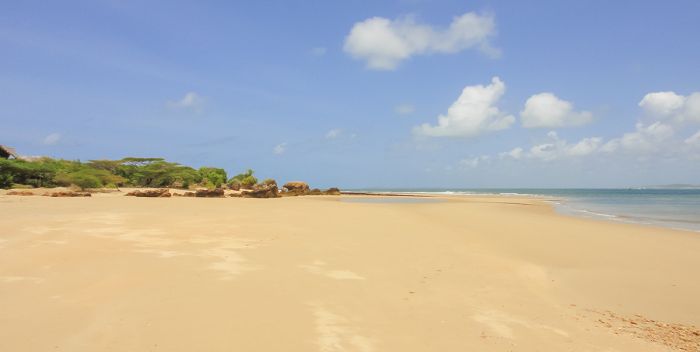
Beach on Manda Island in Kenya's Lamu Archipelago.
The oldest known settlement in the Lamu Islands was the ancient town of Manda (on Manda Island), which dates back to the 8th or 9th centuries. The towns here, of which there are few, still seem to be operating in a time warp, with only a few motorized vehicles to be seen and donkeys common in the narrow alleyways.
The islands of Lamu have retained much of their traditions and other ways of life, providing visitors with a unique glimpse back in time to the days before colonialism grasped much of sub-Saharan Africa, changing it forever.
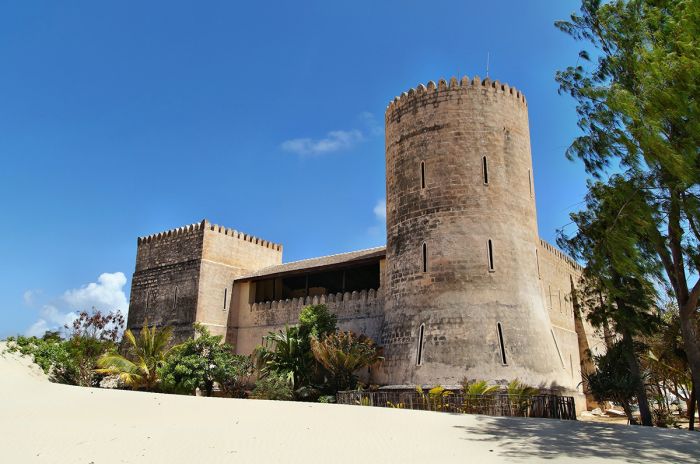
The Fort, an exclusive retreat on Shela Beach, Lamu Island, Kenya.
Lamu Town, on Lamu Island, is the main tourist focus, with several superb accommodations and lots of guesthouses from which to choose. The town, like the rest of this region, seems to be unchanged in recent centuries. The atmosphere is relaxed, some would say even lazy, and feels like stepping back in time. A labyrinth of alleyways, shops and ancient houses lead to the 2-kilometer-long waterfront. The town is an UNESCO World Heritage Site.
The snorkeling in and around the Lamu islands is top-notch, as is diving and game fishing. The beaches are another main focus and most lodges offer all the water sports you can imagine. Most of the islands can be visited and only a few have inhabitants, and are home to ancient settlements, long since abandoned.
Lamu can be reached by air from either Mombasa (around 55 minutes) or Nairobi (2 hours). Driving is an option as well - 5 hours from Mombasa and 9 hours from Nairobi.
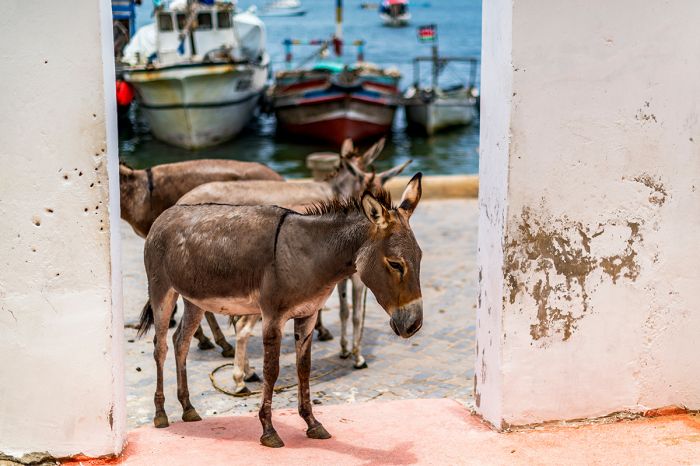
Donkeys are the main mode of transporting goods in Lamu Town.
Kiunga Marine National Reserve
Located along the far northern Indian Ocean coast of Kenya, the Kiunga Marine National Reserve protects 111 square miles (287 sq kms) some 50 calcareous islands, offshore water, coral reefs, and marine life habitats in the Lamu Archipelago.
The reserve was created in 1979 to protect the fragile marine ecosystems that include extensive coral reefs, sea grass beds, mangrove forests, coastal scrub, and open water that is home to myriad marine life, including sea turtles, dugongs, octopus, dolphins, whales, invertebrates, and myriad fish.
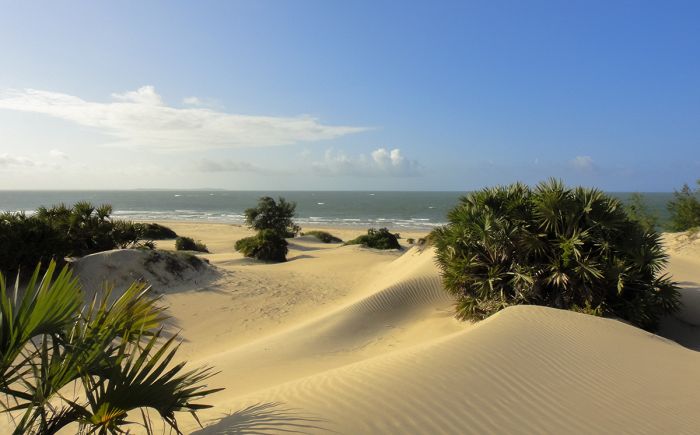
There are 50 islands of the Lamu Archipelago protected in the Kiunga Marine National Reserve, Kenya.
The outer islands are used as nesting sites by various species of seabird, including sooty gull, roseate tern, bridled tern, white-cheeked tern, crab plover, and brown noddy.
The desert island of Kiwayu is very popular getaway within the reserve. The island can be reached on a dhow from Lamu, but takes roughly a day in each direction making it part of the fun. There is also an airstrip on the mainland allowing for a fast boat ride across the channel to the island. Trips can be prearranged complete with overnight camping and activities during the day.
Snorkeling, diving, and boating are permitted in the reserve. Diving here is excellent with superb views of fish and other life on the coral reefs in warm Indian Ocean waters.

Goats on the beach, Lamu Island, Kenya.
Kisite-Mpunguti Marine National Park
Located just offshore along Kenya's extreme southern coast is the Kisite-Mpunguti Marine National Park. The park affords protection of various small coral rag islands, including Kisite Island, and the coral reef habitats that fringe them.
Kisite-Mpunguti protects 11 square miles (28 sq kms) of warm and usually calm water and has some of the best snorkeling anywhere in Kenya.
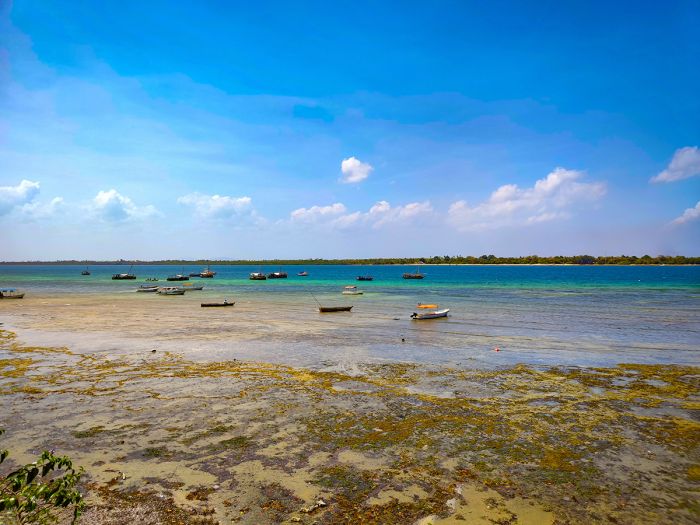
View of boats and blue waters from Wasini Island, Kenya.
Wasini Island is located closer to shore and outside the national park, but also has good spots for diving and snorkeling. Besides the abundant and diverse fish and invertebrate life living in the coral gardens, dolphins are commonly seen in these waters.
Various local operators offer excursions for diving and snorkeling and visitors staying at Diani Beach just to the north are recommended to set aside a day to snorkel in the park. The islands also host large numbers of sea birds.
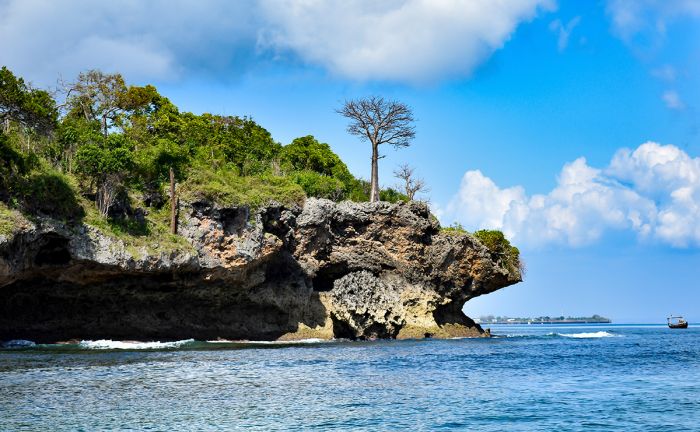
The extreme southern coast of Kenya offers excellent snorkeling around various coral rag islands.
Mombasa
Mombasa is Kenya's largest port city and its second-most populated (after Nairobi), with a total metro area population of over 1.3 million people. The original portion of the city is located on an island within an inlet and connected to the mainland by causeways to the west, a bridge to the north, and a ferry going to the south.
Mombasa has long been a strategic port and trading center on the Indian Ocean trade route and, as such, has been fought over and changed hands over the centuries.
Mombasa's earliest settlements are likely to have been Bantu in origin and date back to as early as 900 AD. Vasco da Gama, the famous Portuguese explorer was the format European to visit Mombasa in 1498 and the Portuguese returned two years later ands sacked the city.
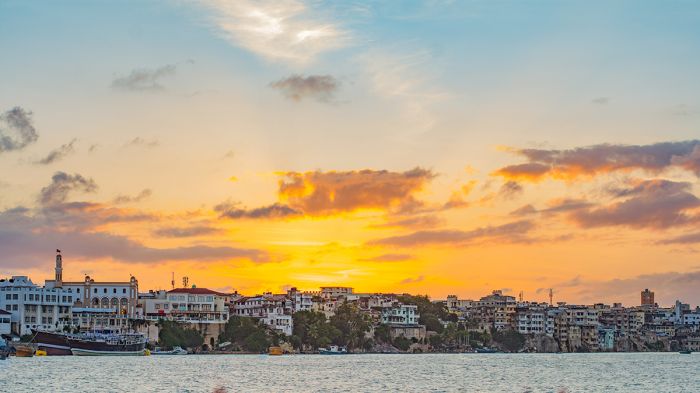
View of Mombasa's waterfront at sunset.
Portugal gained control of Mombasa in 1593 and over the next three years, built Fort Jesus to protect their new strategic port city. Over 100 years later, in 1698, the Omani Empire attacked Fort Jesus and took control of Mombasa.
Finally, in 1887, Britain gained control of Mombasa, holding on to it until Kenya's independence in 1963.
Mombasa is not typically considered as a destination for most tourists, but more as a stopover en route to one of Kenya's coastal resort destinations. However, the city has plenty to offer, including tourist sites such as Fort Jesus, Mombasa's Old Town, numerous historical buildings and museums, and excellent beaches north of the city.
Mombasa's Moi International Airport services destinations throughout Kenya and major cities in Africa.
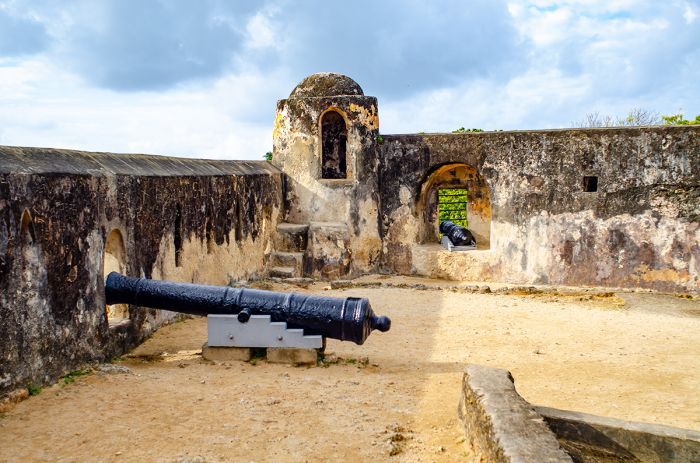
Fort Jesus in Mombasa, Kenya.
Mombasa Marine National Park & Reserve
Situated directly offshore of Mombasa's northern beaches in the 81-square-mile (210-sq-km) are the Mombasa Marine National Park and Mombasa Marine National Reserve. The national park portion only comprises 5% of the total area, with the lesser protected national reserve making up the majority of the combined protected waters.
The park and reserve were established in 1986 two protect important coral reef habitats that are hot to myriad fishes, invertebrates, and marine mammals living offshore from the great city of Mombasa.
The protected area runs from Mtwapa Creek to the north of the city to Tudor Creek, which runs alongside Mombasa Island in the south. The beaches along this stretch of coastline are used by tourists and locals and a stretch of coral reef known as the Bamburi-Nyali Reef extends the entire length just offshore.
Activities in the park and reserve include swimming, snorkeling, diving, wind surfing, and more. The coral reefs are excellent for snorkeling and sea birds are abundant here as well.
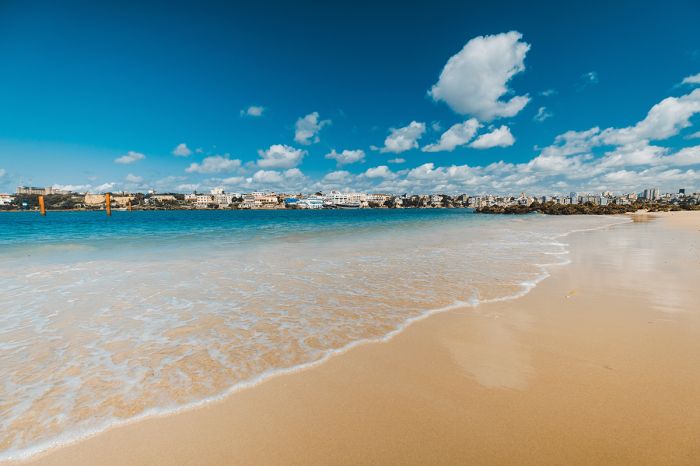
Beach view looking towards the city of Mombasa, Kenya.
Read More...
Arabuko Sokoke, Diani Beach, History, Kisite-Mpunguti, Kiunga, Lamu, Malindi, Mombasa, Mombasa Marine NP, Shimba Hills, South Coast, Watamu
Great Good Fair Poor
- Jan
- Feb
- Mar
- Apr
- May
- Jun
- Jul
- Aug
- Sep
- Oct
- Nov
- Dec
Kenya's Indian Ocean coast is hot and humid throughout the year, with temperatures averaging between 81-88°F (27-31°C). Rains can occur along the Indian Ocean coast at any time throughout the year, but the wettest months are Apr thru June.
Mid-March thru May are exceptionally hot and humid, so those wishing to avoid these tropical conditions should avoid this time.
Kenya's coastline is lengthy, so be sure to check the 'When to Visit' tab on the individual property pages for more detailed information.
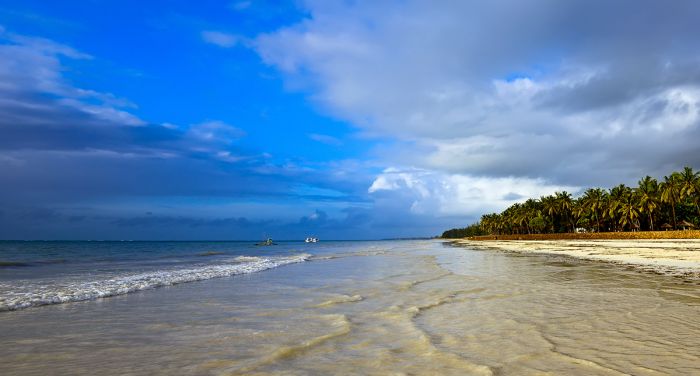
Indian Ocean scene on Diani Beach, Kenya.
The best months for the Kenya coast are October thru January. Snorkeling and diving are very good, with clear waters and the humidity is at its lowest (although the coast is always humid). October, November and March are the best months for underwater visibility.
Water temperatures are warm all year (77-86°F/25-30°C). July thru September can be very windy, with choppy seas. December thru February is hot, dry and the seas are calm.
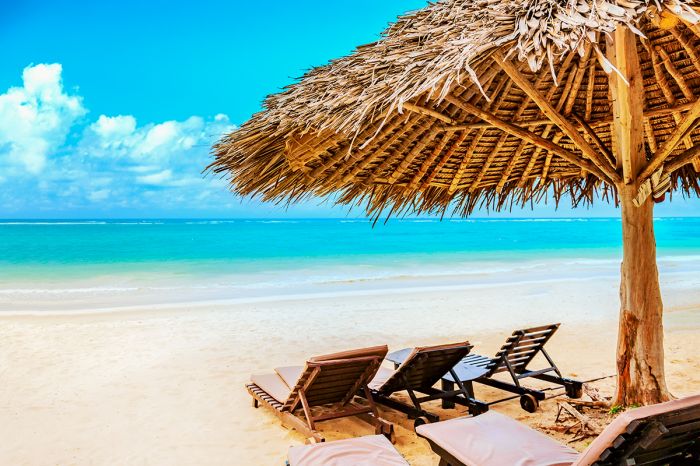
Beach scene in Diani Beach, Kenya.




